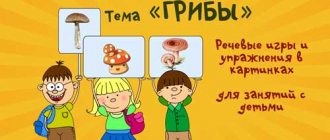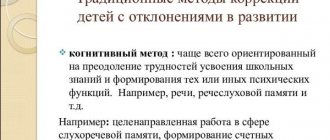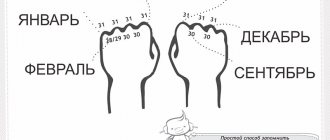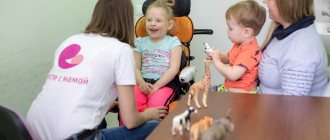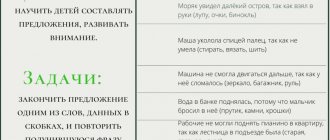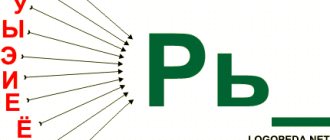Neuropsychological games and exercises in working with preschool children
Antonova Tatyana Konstantinovna
Neuropsychological games and exercises in working with preschool children
Abstract: The work is devoted to the use of neuropsychological knowledge and skills in classes with preschool children in order to reduce the level of perinatal pathology. The compiled set of activities for children in this category helps to activate interhemispheric interaction, which forms the child’s resistance to stress in school. When using neuropsychological games and exercises in classes, children improve memory, self-control of behavior, increase concentration, develop spatial orientation, and increase self-confidence.
Keywords: psychological health, neuropsychological exercises , preschoolers .
An urgent problem in our country is ensuring the mental and psychological health of the younger generation. In the term “mental health”
concepts such as
“human psychology”
and
“health psychology”
.
“Mental health”
as a set of normally functioning mental mechanisms and processes.
The term “psychological health”
, according to I. V. Dubrovina [2, p.
28], characterizes the personality as a whole and evaluates the manifestations of the human spirit. For preschoolers , the criterion of psychological health is the harmony of the child and society.
Many modern experts believe that without psychological health it is impossible to talk about the self-sufficiency of an individual. In recent years, fewer and fewer children with the first health group have been born. There is an increase in the incidence of various neuropsychic disorders, the prevalence of pathologies of pregnancy and childbirth, somatic diseases and other pathological conditions in childhood , leading to mental development disorders, is increasing. Perinatal pathology of the central nervous system, even in the case of a favorable outcome, has long-term consequences and negatively affects the mental development and social adaptation of the child. Unfortunately, in most cases, children with this type of pathology disappear from the attention of specialists after the first year of life. To avoid this, it is necessary to use an integrated approach to this problem [3, p. 5]. Only the joint activities of specialists can improve the health and harmonize the development of the younger generation. Neuropsychology of childhood is one of the disciplines that develops scientific and applied aspects of health-saving technologies for children.
The psychological health of a preschool child is characterized by the development of mental processes, mental performance , the predominance of positive emotions over negative ones, adequate self-esteem, the level of maturity of the processes of excitation and inhibition, self-confidence and self-confidence.
In kindergarten, every specialist uses health-saving technologies in their work . In the classes of a teacher-psychologist, physical exercises, breathing exercises, finger exercises, eye exercises, psycho-gymnastics, play therapy, and sand therapy are used. When working with different age categories of children, it is worth noting that a number of pupils experience difficulties concentrating and switching attention, a slight decrease in auditory-verbal memory, motor impairment, difficulties in drawing, cutting, designing, mild speech deviations and peculiarities of the emotional sphere.
For the successful learning and development of a child at school, one of the main conditions is the full development of interhemispheric interaction preschool Neuropsychological exercises develop the corpus callosum, increase stress resistance, synchronize the work of the hemispheres , improve mental activity, help improve memory and attention, and facilitate the process of reading and writing [1, p. 189]. When preparing children for school, it is necessary to pay great attention to the development of the corpus callosum (interhemispheric connections)
. After all, a violation of the corpus callosum distorts cognitive activity. The main development of interhemispheric connections is formed in girls up to seven years old, in boys up to eight to eight and a half years old.
We have compiled a set of neuropsychological exercises (V. S. Kolganova, E. V. Pivovarova, I. I. Pravednikova)
for classes with
children of the preparatory group [3, p. 12]. This complex includes breathing exercises , oculomotor exercises , stretching, and motor repertoire
exercises Group classes are held once a week. The article presents exercises that can be included in various types of classes as physical exercises.
Breathing exercises . Such exercises are aimed at restoring normal breathing at rest, as well as in combination with various movements, which contributes to increased oxygen supply to all organs and tissues of the body, optimization of muscle tone, reduction of excitability, and improvement of the child’s general condition.
"Balloon"
.
I. p. The child is standing (or sitting)
.
Hands are on the stomach. At the adult’s command “inhale,”
the child takes a deep breath through his nose
(mouth closed)
and inflates his stomach like a balloon, then, at the command
“exhale,”
the child exhales noisily through his mouth, simultaneously with the exhalation he draws in his stomach.
"Fist-finger"
.
I. p. The child is sitting or standing. During the adult’s command “inhale,”
the child inhales through the nose (mouth closed, while simultaneously turning his thumbs up. During the adult’s command
“exhale,”
the child exhales through a wide open mouth, while simultaneously turning his thumbs down. Breathing is slow and deep. Move only hands.
"Fist-palm"
.
I.p. The child stands with his feet shoulder-width apart. Head straight, eyes looking forward. The arms are extended to the sides, the palm of one hand “looks down”
, the fingers look to the side, the palm of the other hand is clenched into a fist.
During the adult’s command to “inhale,”
the child simultaneously unclenches the fist of one hand, the palm
“looks”
at the floor, and the palm of the other hand clenches into a fist.
During the adult’s command to “exhale,”
the child simultaneously changes the position of his fist and palm. Breathe, quickly changing the position of your fist and palm alternately.
Oculomotor exercises . By the age of three, a child should be able to evaluate space by 1800 vertically and 1800 horizontally and track this without turning his head. Very often, children have narrowed fields of visual perception. If the scope of visual perception is narrowed, the child sees only what is in front of him. He notices the rest only by turning his head and the whole body. And it is not surprising that this child can be quite traumatic and gets tired very quickly.
“Following the subject”
. I. p. The child is standing (sitting, head motionless, mouth closed.
Level 1. Straight arms.
1) The child holds a pen with a bright cap (small toy, candy)
above the bridge of the nose, first with the right straight hand and leads it to the right, lingers for 1-2 seconds at the end point, leads it back to the middle. The head does not move, the child's eyes follow the tip of the pen.
2) The child transfers the pen to his left hand. He holds the pen above the bridge of his nose with his left straight hand and moves it to the left, holds it for 1-2 seconds at the end point and leads it back to the middle. The head does not move, the child's eyes follow the tip of the pen.
3) The child takes the handle above the bridge of the nose with two straight hands and leads it up, holds it for 1-2 seconds at the end point and leads it back to the middle. The head does not move, the child's eyes follow the tip of the pen.
4) The child holds the handle above the bridge of the nose with two straight hands and moves it down. Then he holds the handle for 1-2 seconds at the end point and leads back to the middle. The head does not move, the child's eyes follow the tip of the pen.
5) The child holds the handle over the bridge of the nose with two straight lines. Leads the pen to the bridge of the nose (while moving to the bridge of the nose and back, the arms do not bend, holds the pen for 1-2 seconds near the bridge of the nose and leads back to the middle. The head does not move, the child’s eyes follow the tip of the pen.
During this exercise, are straight and do not bend at the elbows (during movement to the bridge of the nose and back, the arms are bent)
.
Level 2. The same exercise is performed with arms bent at the elbows.
The exercise is performed no more than two times at each level.
Motor repertoire exercises In the process of performing exercises of the motor repertoire, a gradual development of the space of one’s own body and the space around one’s body occurs. Practicing concepts such as “top-bottom”
,
“front-behind”
,
“right-left”
, is a good prevention of writing, reading and counting disorders in older
preschoolers .
"Mirror"
. The adult stands opposite the child. The adult reminds the child that if you stand facing each other, right and left change.
1) At the direction of an adult, the child must first show himself, then the adult’s left arm, right shoulder, left knee, etc.
2) The adult shows the movements, the child must repeat them. Moreover, if an adult performs a movement with his right hand, then the child must also perform the movement with his right hand. For example, an adult touches his left ear with his left hand, a child should also touch his left ear with his left hand.
3) The adult and the child change roles: the child commands and checks the correctness of the task. The adult completes the task. To make the exercise more effective , an adult is recommended to make mistakes sometimes; the child should notice this.
"Robot in search of treasure"
.
The child must portray a robot that accurately and correctly carries out the adult’s commands. The adult explains and shows the child what an extension step is. The child takes a step with one foot, and then places the other foot next to the first. Then the adult asks and works with the child: the number of steps; type of steps (large, medium, small)
;
direction of movement (forward, backward, right, left, turn right, turn left)
; Which foot should you take a step on?
1) An adult says: “You will follow my commands. If I say "step forward"
, you will take a step forward.
If I say “two steps to the left
,” you take two steps to the left.
If I say “big steps”
, you take big steps, etc.”
2) If the child has mastered this exercise , the adult can give two, three or four commands at once, for example: “step forward; then turn right; four small steps forward; three big steps back, starting with the right foot, etc.” And if you put a surprise at the end point, the exercise will become even more enjoyable.
exercises are suggested to develop attention :
"Damn the leaf"
.
At the same time, with both hands, the child crumples two pieces of paper and then smoothes them out. The exercise is performed on weight . The faster the child does this, the better. The smaller the size of the pieces of paper, the more difficult it is to perform the exercise .
"Castle"
.
The child clasps his hands and twists his thumbs around each other, first in one direction, then in the other. The exercise is performed as quickly as possible.
The child should look intently at the thumbs. Using these exercises in classes with children (especially older preschool age )
contributes to the activation of interhemispheric interaction, which forms the child’s resistance to stress in school.
To summarize the above, we can draw the following conclusion: when using neuropsychological games and exercises in classes, children improve memory, self-control of behavior, increase concentration, develop spatial orientations, and increase self-confidence. And this, in turn, is one of the main criteria for the psychological health of preschool children .
Bibliography:
1. Wiesel, T. G. Fundamentals of neuropsychology : a textbook for university students / T. G. Wiesel. – M.: V. Sekachev, 2022. – 264 p., color insert 12 p.
2. Dubrovina, I.V. et al. Psychology: Textbook for students. avg. ped. establishments/I. V. Dubrovina, E. E. Danilova, A. M. Prikhozhan; edited by I. V. Dubrovina. – M.: Publishing House
, 1999. – 464 p.
3. Kolganova, V.S. Neuropsychological classes with children : At 2 hours Part 1./Valentina Kolganova, Elena Pivovarova, Sergey Kolganov, Irina Friedrich - M.: AIRIS-press, 2022.- 416 pp.: ill.
Indications for use
Neuropsychological exercises for children of primary and senior school age are a kind of test that will accurately determine and assess their health status.
During the assessment, the specialist asks the child to complete simple tasks, after which they can accurately tell about the child’s developmental characteristics and capabilities. It will be very useful to know the strengths and weaknesses of the baby in order to work with them correctly in the future.
Neuropsychology will also be effective if the child:
- there are problems with memory, performance and communication with peers;
- there is a delay in speech development, speech therapy disorders;
- there are disturbances in psychomotor development, sleep, and appetite;
- hyperactivity or vice versa inhibition;
- impulsiveness;
- problems with learning, he does not assimilate the proposed material well.
Neuropsychological exercises for children help improve the situation in the following cases:
- speech underdevelopment;
- DPR (delayed mental and psycho-speech development);
- ADHD (attention deficit hyperactivity disorder);
- autism;
- HIA (limited development opportunities);
- minimal brain function;
- underdevelopment of the brain body;
- mental and emotional disorders.
A specially selected complex will help the specialist to consistently activate each area of the brain separately. The program is developed individually, due to which it is possible to eliminate all violations thanks to tactile-kinesthetic exercises.
Swings and carousels
Heather Wilson/EyeEm/Getty Images
Swings and carousels are more than just fun. When a child rides, different areas of the brain work, including the cerebellum. Use this: smile, reinforce the positive, ask while riding to recite a difficult-to-remember poem, clearly pronounce problematic sounds, count passers-by, count trees. This way you strengthen positive neural connections between educational activities and interesting activities, and create motivation to learn numbers, letters, and pronounce different sounds.
Principles
This young science has its fundamental principles:
- Social conditioning: the formation of psychological processes is possible only in society.
- Material determinism: the basis of the psyche is the work of the nervous system.
- Systematic structure: mental processes have their own strict hierarchy and system, as well as the higher nervous system with its variety of levels.
- Dynamics in development - all functions are in constant motion and change.
- Syndromic: pathological mental processes are based on certain syndromes, which include both anatomical and functional manifestations.
Just like any other medical science, neuropsychology is based on the principles of ethics and deontology, which acquire special significance in relation to higher nervous activity.
The characterization of human psychology as a product of the nervous system and social influence has led to the formation of religious and moral conflicts, so it is important to observe these principles very carefully. Any neuropsychological study must take into account the factor of public opposition in this regard
Any neuropsychological study must take into account the factor of public opposition in this regard.
Training two functions at once
Having worked on the development of one function and received positive results, you can move on to training two functions at once
For example, attention and impulse control or attention and motor control can be trained through play.
When a hyperactive child has experience participating in group games to develop two functions at once, you can gradually begin to engage with him in more complex play forms that involve the development of all functions at once in the same game.
“Listen to the clapping” (Chistyakova M.I., 1990)
Goal: training attention and control of motor activity.
Everyone walks in a circle or moves around the room in a free direction. When the leader claps his hands once, the children should stop and take the “stork” pose (stand on one leg, arms to the sides) or some other pose. If the leader claps twice, the players should take the “frog” pose (sit down, heels together, toes and knees to the sides, hands between the feet on the floor). After three claps, the players resume walking.
“Shouters, whisperers, silencers” (Shevtsova I.V.)
Goal: development of observation, ability to act according to the rule, control of motor activity.
You need to make 3 silhouettes of a palm from multi-colored cardboard: red, yellow, blue. These are signals. When an adult raises a red palm - a “chant” - you can run, scream, make a lot of noise; yellow palm - “whisper” - you can move quietly and whisper, when the signal “silent” - blue palm - children should freeze in place or lie down on the floor and not move. The game should end with silence.
“Giant slalom” Development of attention and control of motor activity.
Two parallel slalom “courses” are made from chairs, which competing teams must overcome, moving backwards at both ends. The one who, while maneuvering between the chairs, touches one of them, returns to the start for a second attempt. The first team to complete the course without errors wins.
"Ball in a Circle"
Standing in a circle, participants throw 1, 2, 3 or more balls to each other, signaling their intentions without using words. The one whose thrown ball was not caught is eliminated.
"Bench"
Control of impulses and motor activity.
Anyone who is eliminated from any game must sit in a chair until it ends. If he gets up from his chair or spins around, the entire team will be penalized or forfeited.
"Climbers"
Concentration, control of impulsive movements
Participants must walk along a free wall, leaning against it over and over again with at least three limbs. Anyone who tears off or moves two limbs at the same time is considered “lost” and returns to the start. The first team to reach the opposite corner wins.
“Edible - inedible”, “Don’t wear black and white”, don’t say “yes” and “no” and similar games that require self-control to avoid impulsive reactions.
Exercises on interaction between the hemispheres of the brain
To successfully develop intelligence, it is important to activate both hemispheres of the brain. Simultaneous or sequential movements of different parts of the body help with this. Activities can be performed standing, sitting or even lying down.
Ask your child to make the same movements with both hands at the same time, for example, clench and unclench fists.
Teach to make different movements - with the index finger of your right hand we write the letter B on the table, and with the index finger of our left hand we write the letter C.
Invite your child to complete tasks, alternating his right and left hands.


